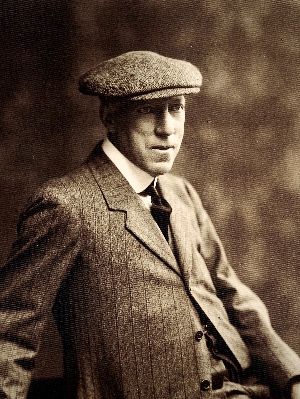Thomas, Jim
Singer
Collection date: May 1913
Area: Cornwall
Jim (James) Thomas at Camborne, Cornwall (1849-1934): age 64, 14 songs - 8 songs on 9 May 1913, 6 more on 6 July 1914: Jim Thomas was a prolific and important singer but there were many families named ‘Thomas’ in the area and it has proved difficult to pin him down. He is not to be confused with James Thomas of Cannington in Somerset, whose photo is in the VWML collection.
In his first batch of songs were 4 carols, notably the ‘Cherry Tree Carol’ (FT2821) and ‘Nine Joys of Mary’ (FT2829). The latter is featured in The New Penguin Book of Folk Songs (Roud, Steve & Bishop, Julia 2012 pp366, 510). Sharp just wrote ‘Mr J.Thomas’ as the singer. In July 1914, however, Sharp helpfully wrote ‘Jim Thomas, age 65’ (FT2983ff) and one of the two shanties performed was ‘Whisky’ (FT2985), where Sharp noted that Jim had learned the song on board The Lily of Washington ship en route for America in 1870. This information provides a date of birth for Jim Thomas of 1849.
Further evidence emerges later when Jim Thomas’ version of ‘Cherry Tree Carol’ (dated May 1913) was published by Sharp in the Journal of the Folk-Song Society 5 (1914 p11). The song was apparently read and copied by James Madison Carpenter, the American song-collector, who made a point of visiting the aged Jim Thomas and his family c1930. Carpenter recorded ‘The First Noell’ (VWML Carpenter JMC/1/1/1/H pp00841, 10975), sung by Miss Bessie Wallace, the granddaughter of Jim Thomas, and her voice can be heard on cylinders from the Library of Congress archives (accessible on VWML website). Carpenter gave the address as 14 Union St (which is in the centre of Camborne town). There do not appear to be any recordings of Jim Thomas himself but Carpenter collected 16 songs from Bessie Wallace and 8 children’s songs from another granddaughter Phyllis Thomas. Typing ‘Carpenter 05915’ into the VWML search box will bring up Carpenter’s typed notes that state that ‘Jim Thomas died Feb 1934 at age of 84’.
Working backwards, we can now reconstruct Jim Thomas’ family history as follows:- His death was recorded in the Camborne parish burials register as ‘Frederick James Thomas of 14 Union St, buried 3/3/1934 aged 84’. The probate register records that he died on 28 February 1934 and left £358 to daughters Elizabeth Wallace and Jane Wright. The 1911 census for Camborne District 2 page 274 listed Fredk James Thomas, 61, a boot repairer, living at 7 William St (adjacent to Union St) with his second wife Elizabeth, 61 (married under a year). Also in the house was his married daughter Elizabeth Eva Wallace, 23 with husband William Ernest Wallace*. James’ other daughter Jane, 16 was also present. Granddaughter Bessie Wallace would be born in 1913 (Jan qr 5c 322) and other granddaughter Phyllis Thomas c1921. In the 1921 census Jim Thomas (widower) is living in Union St, Camborne with daughter Eva , son-in-law William and their daughter Bessie aged 8 yrs 4 months. Jim was still a postman.
*It was common in those days to refer to women by their husband’s initials and Carpenter got mixed up when he quoted that he got a song from Mrs WE Thomas (instead of Mrs WE Wallace).
The 1901 census had Fredk James Thomas at 7 William St, age 51 a shoemaker, but with first wife Eliza, age 49. Daughter Elizabeth E (a dressmaker), son Fredk J (a barber) and daughter Jane were present (ref RG13/2243 f114 p33). The 1891 census also had the family at 7 William St but this time Jane Thomas, widow aged 80, James’ mother was with them.
In all these censuses (Fredk) James Thomas was shown as ‘born at Gwinear’, a village 4 miles SW of Camborne. Jumping back, we can now find him, aged 2 in the 1851 census for Gwinear, as the youngest of 7 children of John Thomas (36), engineer and his wife Jane. Unfortunately John died in the mid-1850s and Jane had to cope on her own. In the 1861 Gwinear census her eldest son John Jr was an engine driver in the mines; daughter Elizabeth was a tailoress; James at school aged 11.
James (Jim) then joined the Merchant Navy as a young man (hence his knowledge of sea shanties) and he was not in the 1871 census. On his return he moved to William St, Camborne to stay with his uncle Joseph Jewell – Joseph had married James’ aunt Eliza Thomas (1837). James married Joseph’s daughter Eliza Jewell in April qr 1881 (5c 284).
One final aspect of Jim Thomas’ life needs further discussion. In his notes for ‘The Holly and the Ivy’ (Carpenter p00858) it’s stated that Jim Thomas was a bard with the name ‘Tas Cambron’. Presumably the family proudly gave Carpenter this ‘bardic’ information, which is corroborated in the Western Morning News (22 Sept 1928). There it was reported that a number of bards had been ceremonially elected at Boscawen-Un at a revival of the Cornish Gorsedh. Among them was ‘James Thomas, Camborne postman, folklorist and collector of flint implements. Bardic name Tas Cambron’. We must therefore assume that at some point in his life Jim Thomas wrote poetry and his folk-singing does indicate a musical ear. Perhaps he combined his shoemaking with being a rural postman. He was his own boss and a man of standing in the community.

